Daily Accessed Street Greenery and Housing Price: Measuring Economic Performance of Human-Scale Streetscapes via New Urban Data
Abstract
1. Introduction
1.1. The Importance of Daily Accessed Street Greenery and the Difficulty of Measuring It
1.2. Hedonic Price Model and Its Recent Developments
1.3. New Research Potentials in the Context of New Urban Data and New Tools
2. Research Methodology
2.1. Analytical Framework
2.2. Case Selection
2.3. Variables and Data
2.3.1. Dependent Variable
2.3.2. Independent Variables
3. Analysis
3.1. Data Preparation
3.2. Regression Analyses via the Linear Regression Model
4. Discussion
4.1. The Positive Impact of Daily Accessed Street Greenery on Housing Price
4.2. The Influential Mechanism between Daily Accessed Street Greenery and Housing Price
5. Conclusions
5.1. Concluding Remarks
5.2. Policy Implication
5.3. Limitations and Next Steps
Author Contributions
Funding
Acknowledgments
Conflicts of Interest
References
- Miller, R.W.; Hauer, R.J.; Werner, L.P. Urban Forestry: Planning and Managing Urban Greenspaces, 2nd ed.; Prentice Hall Inc.: Upper Saddle River, NJ, USA, 1997. [Google Scholar]
- Sharma, D.K.; Bhatt, A.; Kumar, A. An Analytical Study to Find the Major Factors Behind the Great Smog of Delhi, 2016: Using Fundamental Data Sciences. In Proceedings of the International Conference on Recent Developments in Science, Engineering and Technology; Springer: Singapore, 2017; pp. 195–207. [Google Scholar]
- Chen, X.L.; Zhao, H.M.; Li, P.X.; Yin, Z.Y. Remote sensing image-based analysis of the relationship between urban heat island and land use cover changes. Remote Sens. Environ. 2006, 104, 133–146. [Google Scholar] [CrossRef]
- Sanchez, G.M.E.; Van Renterghem, T.; Thomas, P.; Botteldooren, D. The effect of street canyon design on traffic noise exposure along roads. Build. Environ. 2016, 97, 96–110. [Google Scholar] [CrossRef]
- Lin, Y.H.; Tsai, C.C.; Sullivan, W.C.; Chang, P.J.; Chang, C.Y. Does awareness effect the restorative function and perception of street trees? Front. Psychol. 2014, 5, 906. [Google Scholar] [CrossRef] [PubMed]
- Schroeder, H.W.; Cannon, W.N. The esthetic contribution of trees to residential streets in Ohio towns. J. Arboric. 1983, 9, 237–243. [Google Scholar]
- Maas, J. Green Space, Urbanity, and Health: How Strong Is the Relation? J. Epidemiol. Community Health 2006, 60, 587–592. [Google Scholar] [CrossRef] [PubMed]
- Bain, L.; Gray, B.; Rodgers, D. Living Streets: Strategies for Crafting Public Space; John Wiley & Sons: New York, NY, USA, 2012. [Google Scholar]
- Ye, Y.; Richards, D.; Lu, Y.; Song, X.; Zhuang, Y.; Zeng, W.; Zhong, T. Measuring daily accessed street greenery: A human-scale approach for informing better urban planning practices. Landsc. Urban Plan. 2018, in press. [Google Scholar] [CrossRef]
- Yang, J.; Zhao, L.; Mcbride, J.; Gong, P. Can you see green? Assessing the visibility of urban forests in cities. Landsc. Urban Plan. 2009, 91, 97–104. [Google Scholar] [CrossRef]
- Stamps III, A.E. Use of photographs to simulate environments: A meta-analysis. Percept. Mot. Ski. 1990, 71, 907–913. [Google Scholar] [CrossRef]
- Handy, S.L.; Niemeier, D.A. Measuring accessibility: An exploration of issues and alternatives. Environ. Plan. A Econ. Space 1997, 29, 1175–1194. [Google Scholar] [CrossRef]
- Hillier, B. Studying cities to learn about minds: Some possible implications of space syntax for spatial cognition. Environ. Plan. B Plan. Des. 2012, 39, 12–32. [Google Scholar] [CrossRef]
- Camacho-Cervantes, M.; Schondube, J.E.; Castillo, A.; MacGregor-Fors, I. How do people perceive urban trees? Assessing likes and dislikes in relation to the trees of a city. Urban Ecosyst. 2014, 17, 761–773. [Google Scholar] [CrossRef]
- Tan, P.Y.; Wang, J.; Sia, A. Perspectives on five decades of the urban greening of Singapore. Cities 2013, 32, 24–32. [Google Scholar] [CrossRef]
- Rosen, S. Hedonic Prices and Implicit Markets: Product Differentiation in Pure Competition. J. Political Econ. 1974, 82, 34–55. [Google Scholar] [CrossRef]
- Can, A. Specification and Estimation of Hedonic Housing Price Models. Reg. Sci. Urban Econ. 1992, 22, 453–474. [Google Scholar] [CrossRef]
- Freeman, A.M. Hedonic prices, property values and measuring environmental benefits: A survey of the issues. In Measurement in Public Choice, 1st ed.; Strom, S., Ed.; Palgrave Macmillan: London, UK, 1981; pp. 13–32. [Google Scholar]
- Witte, A.D.; Sumka, H.J.; Erekson, H. An Estimate of a Structural Hedonic Price Model of the Housing Market: An Application of Rosens Theory of Implicit Markets. Econometrica 1979, 47, 1151. [Google Scholar] [CrossRef]
- Richardson, H.W.; Gordon, P.; Jun, M.J.; Heikkila, E.; Peiser, R.; Dale-Johnson, D. Residential Property Values, the CBD, and Multiple Nodes: Further Analysis. Environ. Plan. A Econ. Space 1990, 22, 829–833. [Google Scholar] [CrossRef]
- Mahan, B.L.; Polasky, S.; Adams, R.M. Valuing urban wetlands: A property price approach. Land Econ. 2000, 76, 100–113. [Google Scholar] [CrossRef]
- Jim, C.Y.; Chen, W.Y. Value of scenic views: Hedonic assessment of private housing in Hong Kong. Landsc. Urban Plan. 2009, 91, 226–234. [Google Scholar] [CrossRef]
- Zheng, S.; Kahn, M.E.; Liu, H. Towards a system of open cities in China: Home prices, FDI flows and air quality in 35 major cities. Reg. Sci. Urban Econ. 2010, 40, 1–10. [Google Scholar] [CrossRef]
- Caudill, S.B.; Affuso, E.; Yang, M. Registered sex offenders and house prices: An hedonic analysis. Urban Stud. 2015, 52, 2425–2440. [Google Scholar] [CrossRef]
- Yang, L.; Wang, B.; Zhou, J.; Wang, X. Walking accessibility and property prices. Transp. Res. Part D Transp. Environ. 2018, 62, 551–562. [Google Scholar] [CrossRef]
- Boyle, M.; Kiel, K. A survey of house price hedonic studies of the impact of environmental externalities. J. Real Estate Lit. 2001, 9, 117–144. [Google Scholar]
- Arribas, I.; García, F.; Guijarro, F.; Oliver, J.; Tamošiūnienė, R. Mass appraisal of residential real estate using multilevel modelling. Int. J. Strateg. Prop. Manag. 2016, 20, 77–87. [Google Scholar] [CrossRef]
- Xiao, Y.; Webster, C.; Orford, S. Identifying House Price Effects of Changes in Urban Street Configuration: An Empirical Study in Nanjing, China. Urban Stud. 2014, 53, 112–131. [Google Scholar] [CrossRef]
- Xiao, Y.; Orford, S.; Webster, C.J. Urban Configuration, Accessibility, and Property Prices: A Case Study of Cardiff, Wales. Environ. Plan. B Plan. Des. 2015, 43, 108–129. [Google Scholar] [CrossRef]
- Law, S. Defining Street-based Local Area and Measuring Its Effect on House Price Using a Hedonic Price Approach: The Case Study of Metropolitan London. Cities 2017, 60, 166–179. [Google Scholar] [CrossRef]
- Li, X.; Zhang, C.; Li, W.; Kuzovkina, Y.A.; Weiner, D. Who lives in greener neighborhoods? The distribution of street greenery and its association with residents’ socioeconomic conditions in Hartford, Connecticut, USA. Urban For. Urban Green. 2015, 14, 751–759. [Google Scholar] [CrossRef]
- Zhang, Y.; Dong, R. Impacts of Street-Visible Greenery on Housing Prices: Evidence from a Hedonic Price Model and a Massive Street View Image Dataset in Beijing. ISPRS Int. J. Geo-Inf. 2018, 7, 104. [Google Scholar] [CrossRef]
- Long, Y.; Liu, L. Transformations of Urban Studies and Planning in the Big/open Data Era: A Review. Int. J. Image Data Fusion 2016, 7, 295–308. [Google Scholar] [CrossRef]
- Ye, Y.; Li, D.; Liu, X. How block density and typology affect urban vitality: An exploratory analysis in Shenzhen, China. Urban Geogr. 2018, 39, 631–652. [Google Scholar] [CrossRef]
- Yin, L.; Wang, Z. Measuring visual enclosure for street walkability: Using machine learning algorithms and Google Street View imagery. Appl. Geogr. 2016, 76, 147–153. [Google Scholar] [CrossRef]
- Li, X.; Zhang, C.; Li, W.; Ricard, R.; Meng, Q.; Zhang, W. Assessing street-level urban greenery using Google Street View and a modified green view index. Urban For. Urban Green. 2015, 14, 675–685. [Google Scholar] [CrossRef]
- Long, Y.; Liu, L. How green are the streets? An analysis for central areas of Chinese cities using Tencent Street View. PLoS ONE 2017, 12, e0171110. [Google Scholar] [CrossRef] [PubMed]
- Badrinarayanan, V.; Kendall, A.; Cipolla, R. SegNet: A Deep Convolutional Encoder-Decoder Architecture for Image Segmentation. IEEE Trans. Pattern Anal. Mach. Intell. 2017, 39, 2481–2495. [Google Scholar] [CrossRef] [PubMed]
- Ye, Y.; Zeng, W.; Shen, Q.; Zhang, X.; Lu, Y. The visual quality of streets: A human-centred continuous measurement based on machine learning algorithms and street view images. Environ. Plan. B Urban Anal. City Sci. 2019, in press. [Google Scholar] [CrossRef]
- Liu, L.; Silva, E.A.; Wu, C.; Wang, H. A Machine Learning-based Method for the Large-scale Evaluation of the Qualities of the Urban Environment. Comput. Environ. Urban Syst. 2017, 65, 113–125. [Google Scholar] [CrossRef]
- Lu, Y. The association of urban greenness and walking behavior: Using google street view and deep learning techniques to estimate residents’ exposure to urban greenness. Int. J. Environ. Res. Public Health 2018, 15, 1576. [Google Scholar] [CrossRef]
- Lu, Y.; Sarkar, C.; Xiao, Y. The effect of street-level greenery on walking behavior: Evidence from Hong Kong. Soc. Sci. Med. 2018, 208, 41–49. [Google Scholar] [CrossRef]
- Hillier, B.; Penn, A.; Banister, D.; Xu, J. Configurational modelling of urban movement network. Environ. Plan. B Plan. Des. 1998, 25, 59–84. [Google Scholar]
- Turner, A. From axial to road-centre lines: A new representation for space syntax and a new model of route choice for transport network analysis. Environ. Plan. B Plan. Des. 2007, 34, 539–555. [Google Scholar] [CrossRef]
- Ye, Y.; Yeh, A.; Zhuang, Y.; Van Nes, A.; Liu, J. “Form Syntax” as a contribution to geodesign: A morphological tool for urbanity-making in urban design. Urban Des. Int. 2017, 22, 73–90. [Google Scholar] [CrossRef]
- Al-Sayed, K.; Turner, A.; Hillier, B.; Iida, S.; Penn, A. Space Syntax Methodology. 2014. Available online: http://discovery.ucl.ac.uk/1415080/ (accessed on 10 February 2019).
- Kong, F.; Nakagoshi, N. Spatial-temporal Gradient Analysis of Urban Green Spaces in Jinan, China. Landsc. Urban Plan. 2006, 78, 147–164. [Google Scholar] [CrossRef]
- Morancho, A.B. A Hedonic Valuation of Urban Green Areas. Landsc. Urban Plan. 2003, 66, 35–41. [Google Scholar] [CrossRef]
- Chen, W.Y.; Jim, C.Y. Amenities and Disamenities: A Hedonic Analysis of the Heterogeneous Urban Landscape in Shenzhen (China). Geogr. J. 2010, 176, 227–240. [Google Scholar] [CrossRef]
- Sun, X.; Wang, W.; Sun, T.; Wang, Y. Understanding the Living Conditions of Chinese Urban Neighborhoods through Social Infrastructure Configurations: The Case Study of Tianjin. Sustainability 2018, 10, 3243. [Google Scholar] [CrossRef]
- Baidu Maps API. Available online: http://developer.baidu.com/map/reference/ (accessed on 22 January 2019).
- Bargh, A.; Chen, M.; Burrows, L. Automaticity of Social Behavior: Direct Effects of Trait Construct and Stereotype Activation on Action. J. Personal. Soc. Psychol. 1996, 71, 230–244. [Google Scholar] [CrossRef]
- Hillier, B.; Iida, S. Network and psychological effects in urban movement. In Proceedings of the International Conference on Spatial Information Theory; Springer: Berlin/Heidelberg, Germany, 2005; pp. 475–490. [Google Scholar]
- Travel Behavior Report of Four Megacities in China Based on Tencent Big Data. Available online: http://tech.qq.com/a/20170213/006139.htm#p=1 (accessed on 10 February 2019). (In Chinese).
- People’s Bank of China. Shanghai Financial Operation Report 2017. Available online: https://www.chinawealth.com.cn/resource/830/846/863/51198/52005/1223984/1502092739861675397052.pdf (accessed on 2 March 2019).
- Zhou, Z. Housing market sentiment and intervention effectiveness: Evidence from China. Emerg. Mark. Rev. 2018, 35, 91–110. [Google Scholar] [CrossRef]
- Yang, L.; Zhou, J.; Shyr, O.F. Does bus accessibility affect property prices? Cities 2019, 84, 56–65. [Google Scholar] [CrossRef]
- Yang, L.; Wang, B.; Zhang, Y.; Ye, Z.; Wang, Y.; Li, P. Willing to pay more for high-quality schools? Int. Rev. Spat. Plan. Sustain. Dev. 2018, 6, 45–62. [Google Scholar] [CrossRef]
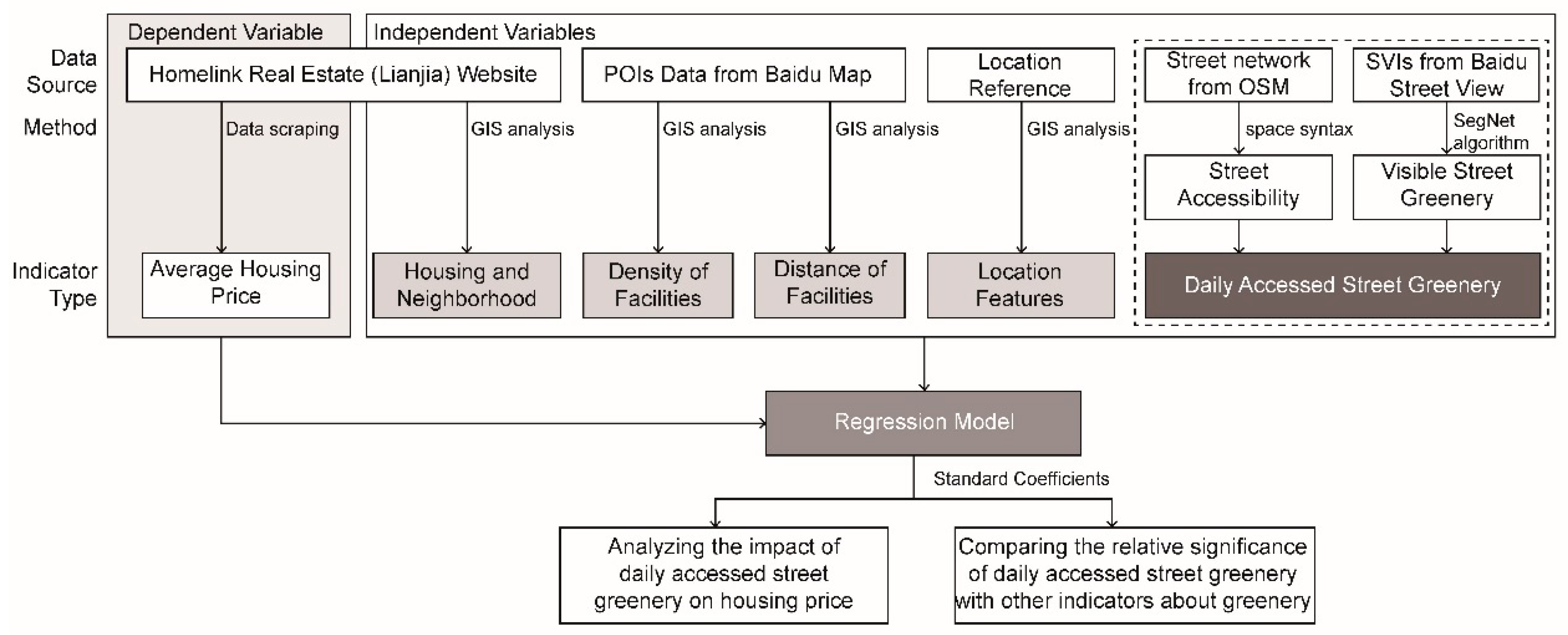
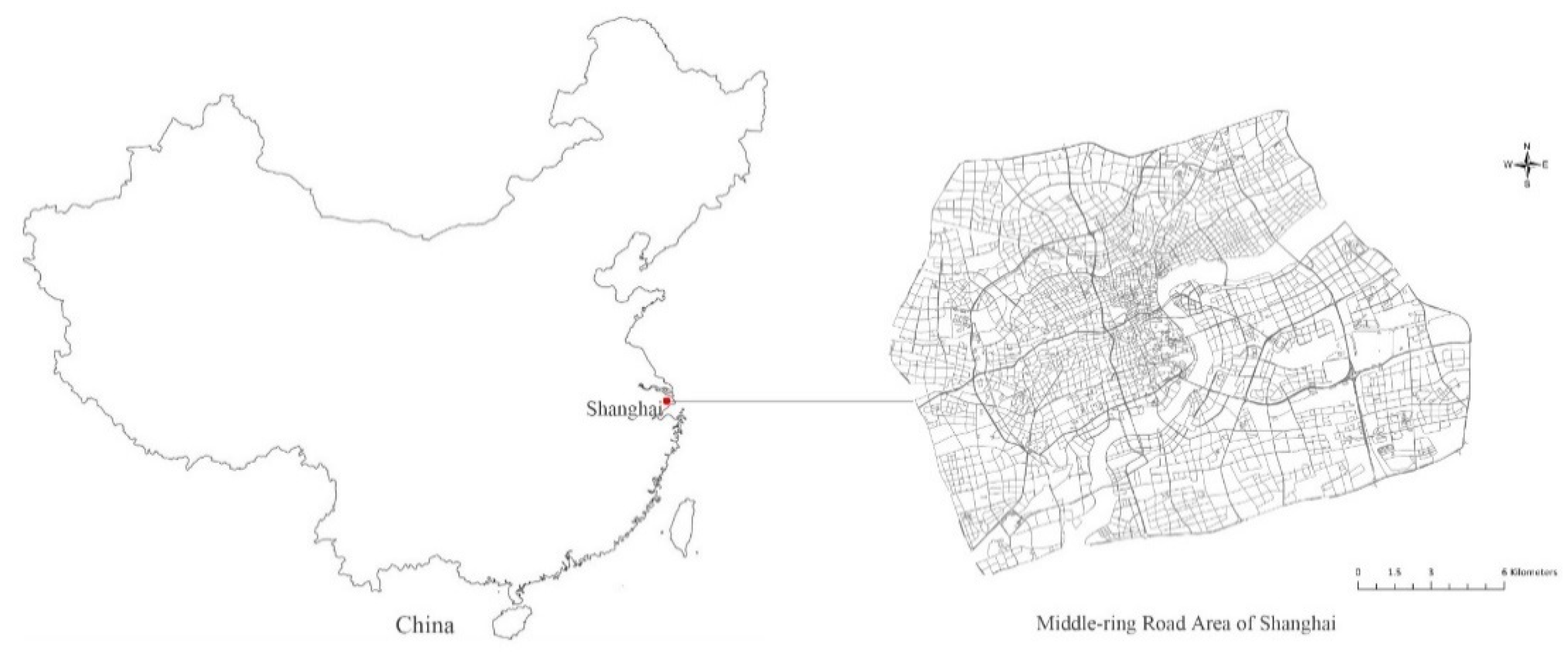

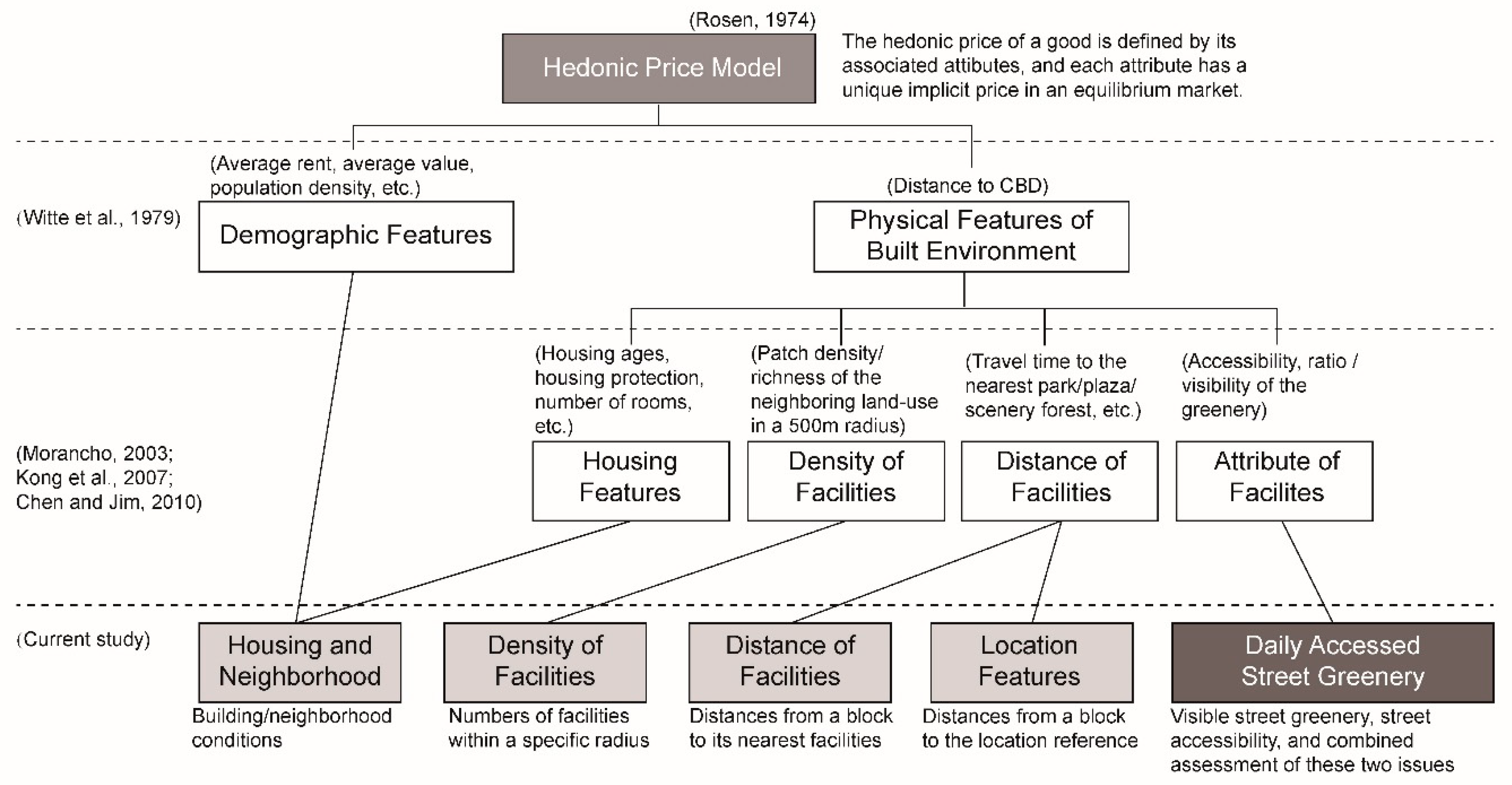
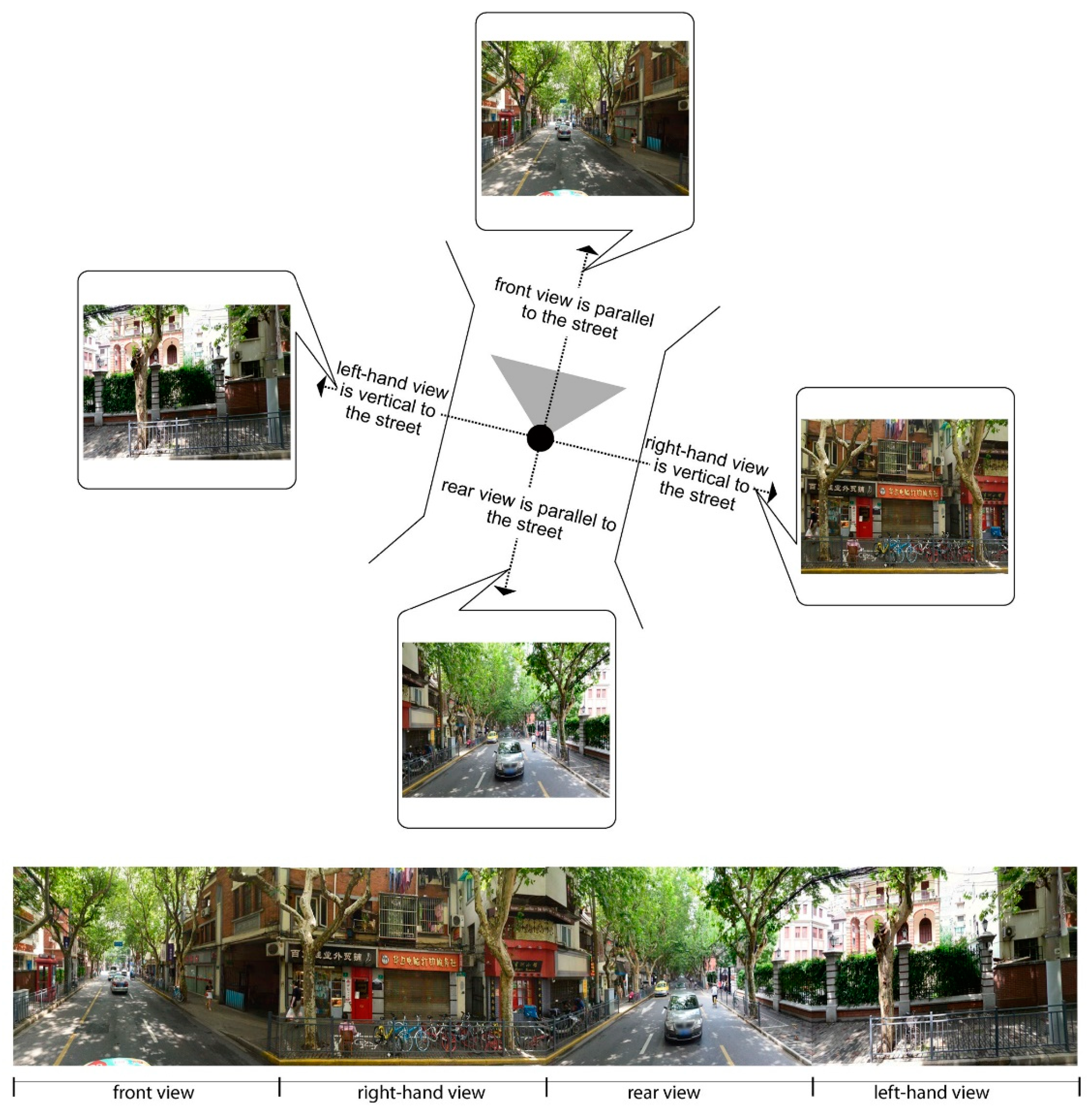



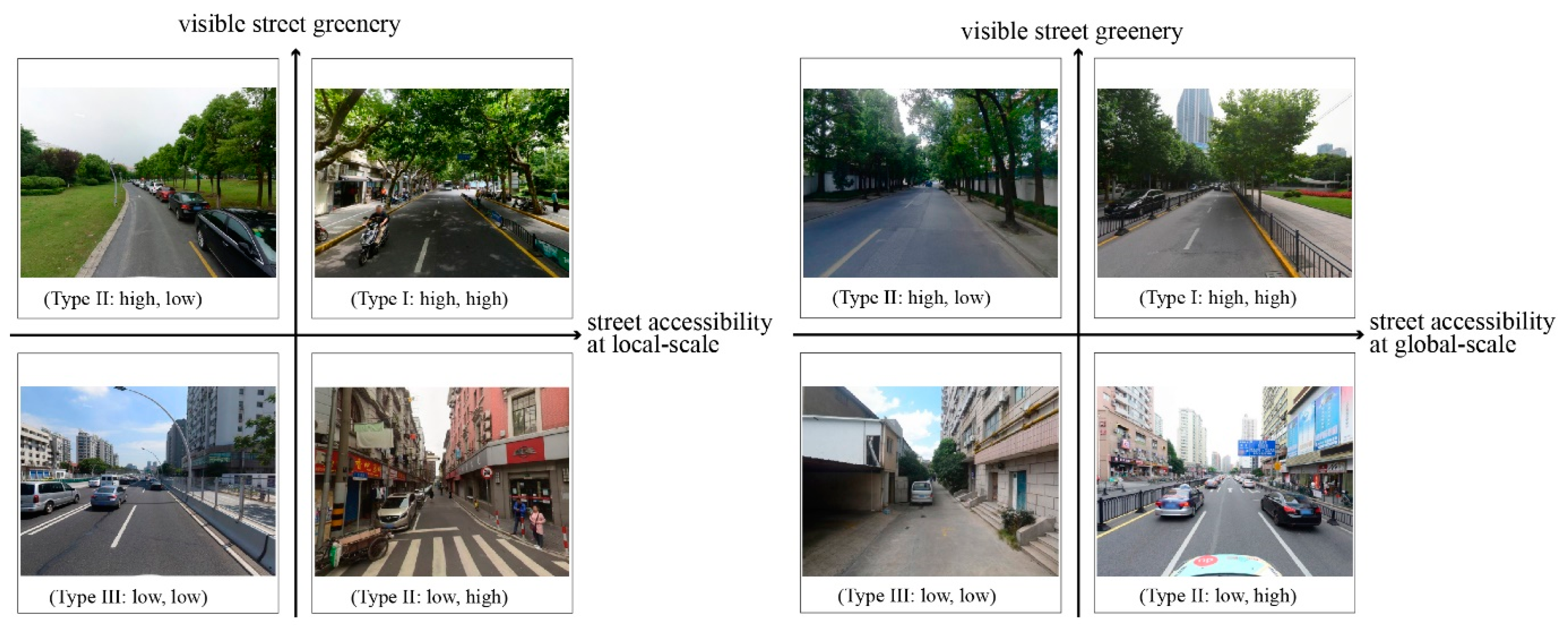
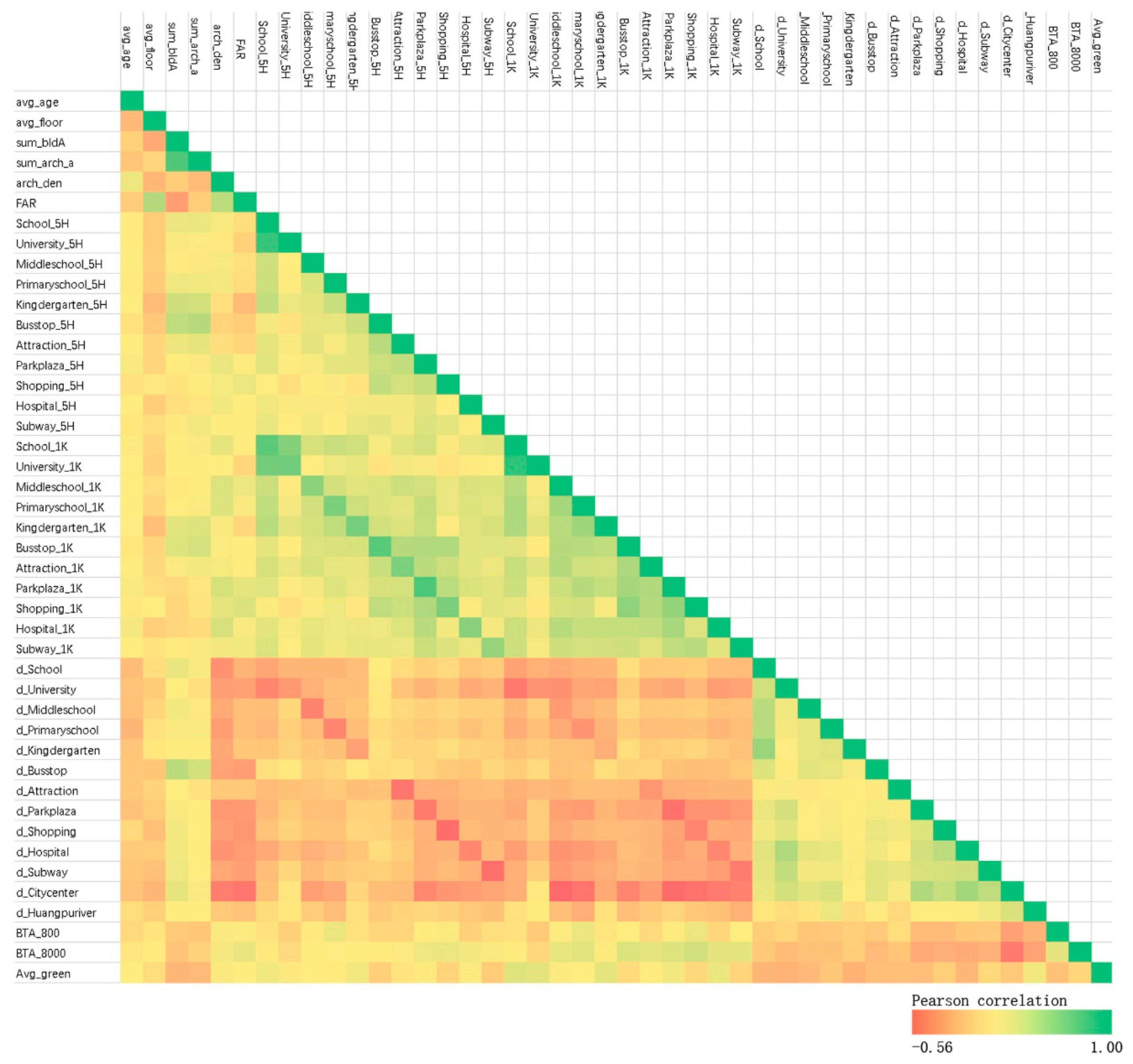
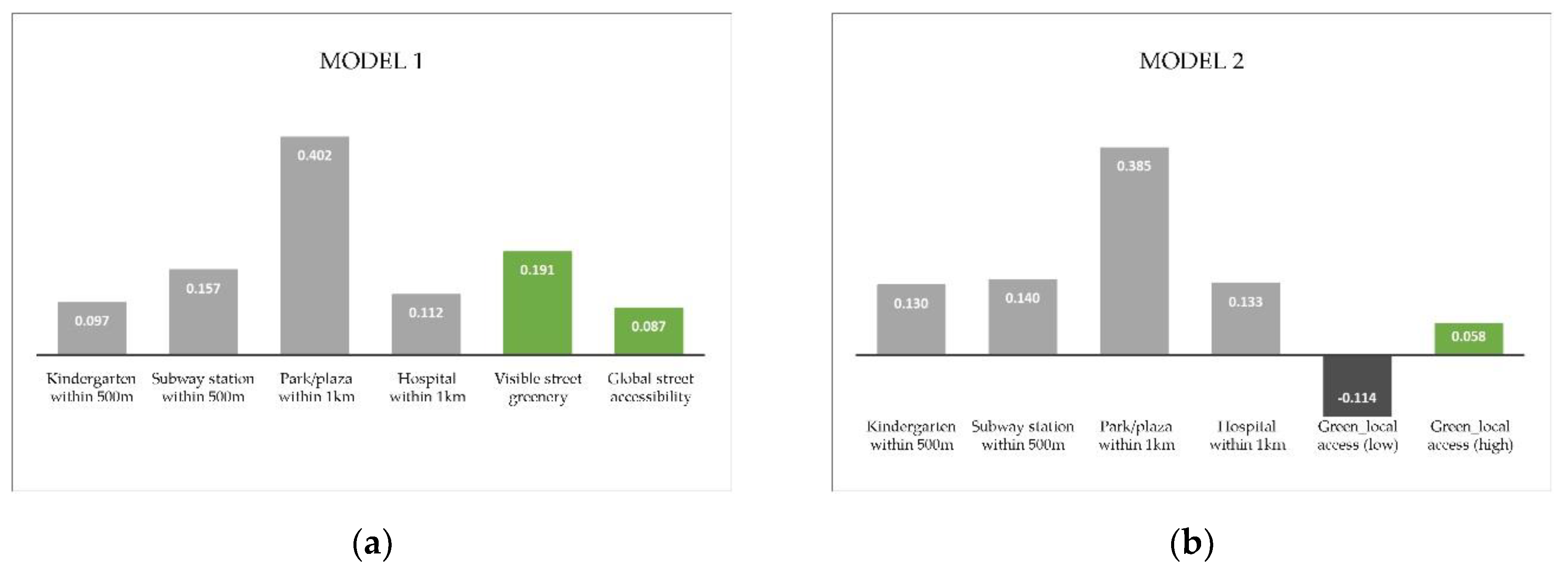

| Indicator Types | Variables | Description and Distribution |
|---|---|---|
| Housing and neighborhood features | Avg_age Avg_floor Sum_bldA Sum_arch_a Arch_den FAR | Average age of the private neighborhood. Average building stories of the private neighborhood. Gross building area of the private neighborhood. Total floor area of the private neighborhood. Building density of the private neighborhood. Floor area ratio of the private neighborhood. 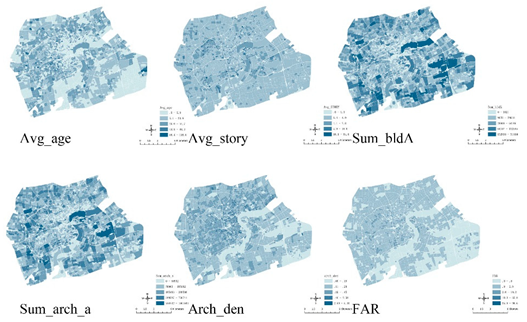 |
| Density of facilities (PoIs) | School_5H University_5H Middleschool_5H Primaryschool_5H Kindergarten_5H Busstop_5H Attraction_5H Parkplaza_5H Shopping_5H Hospital_5H Subway_5H | The number of PoIs within the 500 m buffer of the neighborhood centroid.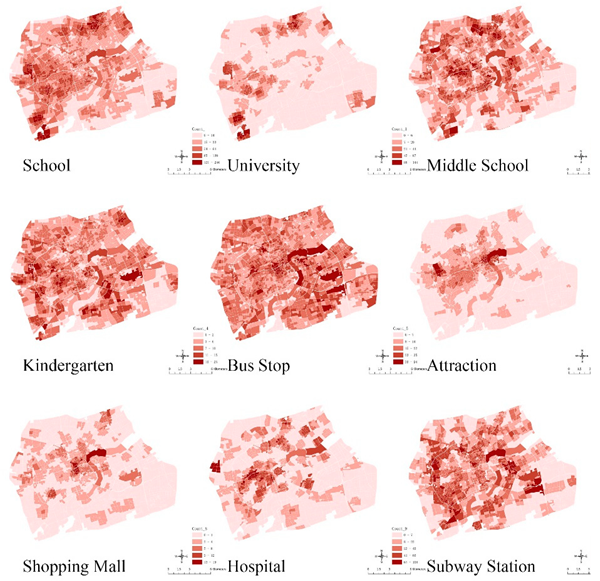 |
| School_1K University_1K Middleschool_1K Primaryschool_1K Kindergarten_1K Busstop_1K Attraction_1K Parkplaza_1K Shopping_1K Hospital_1K Subway_1K | The number of PoIs within the 1000 m buffer of the neighborhood centroid.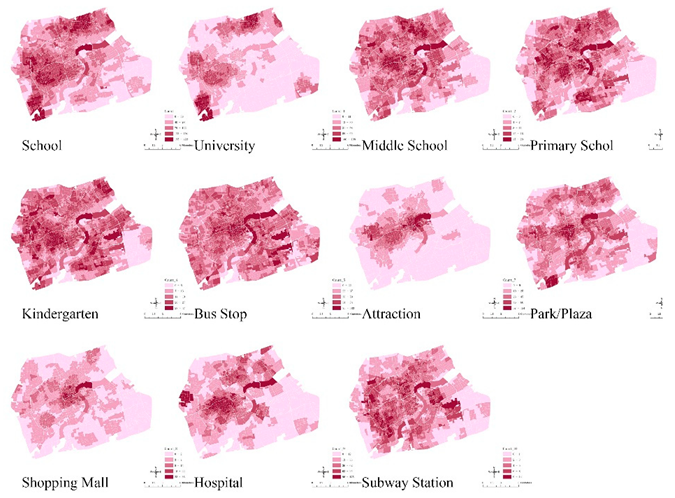 | |
| Distance of facilities (PoIs) | d_School d_University d_Middleschool d_Primaryschool d_Kindergarten d_Busstop d_Attraction d_Parkplaza d_Shopping d_Hospital d_Subway | The distances from each neighborhood centroid to the corresponding nearest PoIs.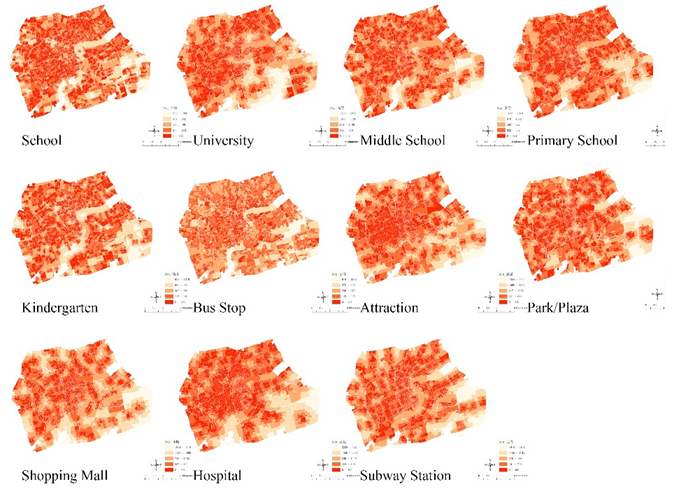 |
| Location features | d_Citycenter d_Huangpuriver | The distances from each neighborhood centroid to the city center and the Huangpu River. |
| Daily accessed street greenery | BTA_800 BTA_6200 Avg_Green Combined_assessment | Local street accessibility for pedestrians (sDNA 800 m) Global street accessibility for commuting behaviors. (sDNA 6200 m) Average human-scale street greenery calculated by the SegNet algorithm, based on the Baidu street view image dataset. Combined assessment of both greenery and accessibility 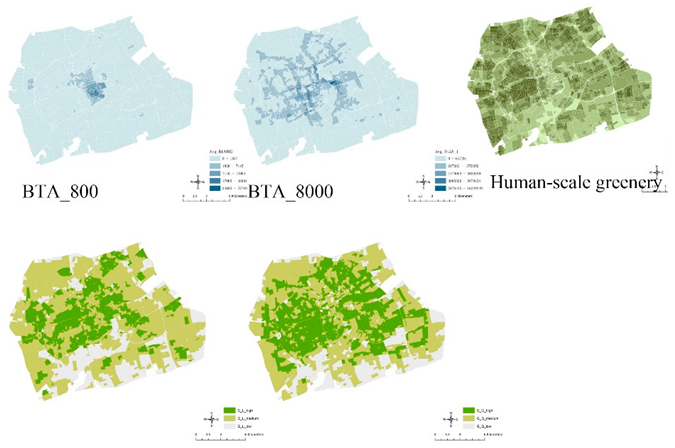 |
| Adjusted R Square | Std Error of the Estimate | Sig. | N | |
|---|---|---|---|---|
| Model 0 | 0.268 | 12793.216 | 0.000 ** | 1395 |
| Model 1 | 0.301 | 12501.679 | 0.000 ** | 1395 |
| Model 2 | 0.285 | 12647.556 | 0.000 ** | 1395 |
| Model 1 | Model 2 | ||||
|---|---|---|---|---|---|
| Variables | Standardized Coefficients (Beta) | Sig. | Variables | Standardized Coefficients (Beta) | Sig. |
| Avg_age | −0.073 | 0.002 ** | Avg_age | −0.068 | 0.005 ** |
| Avg_story | 0.062 | 0.011 * | Avg_story | 0.067 | 0.008** |
| Sum_arch_a | −0.108 | 0.001 ** | Sum_bldA | −0.124 | 0.000 ** |
| Arch_den | −0.153 | 0.000 ** | Arch_den | −0.159 | 0.000 ** |
| Kindergarten_5H | 0.097 | 0.001 ** | Kindergarten_5H | 0.130 | 0.000 ** |
| Parkplaza_5H | −0.164 | 0.000 ** | Parkplaza_5H | −0.159 | 0.000 ** |
| Subway_5H | 0.087 | 0.000 ** | Subway_5H | 0.057 | 0.022 * |
| Primaryschool_1K | −0.108 | 0.000 ** | Primaryschool_1K | −0.112 | 0.000 ** |
| Busstop_1K | 0.157 | 0.001 ** | Attraction_1K | 0.064 | 0.025 * |
| Parkplaza_1K | 0.402 | 0.000 ** | Parkplaza_1K | 0.385 | 0.000 ** |
| Hosptial_1K | 0.112 | 0.000 ** | Hosptial_1K | 0.133 | 0.000 ** |
| d_Huangpuriver | −0.196 | 0.000 ** | d_Huangpuriver | −0.167 | 0.007 ** |
| d_Citycenter | −0.079 | 0.031 * | |||
| d_Primaryschool | 0.063 | 0.015 * | d_Primaryschool | 0.071 | 0.007 * |
| d_Busstop | 0.076 | 0.005 ** | d_Busstop | 0.078 | 0.004 ** |
| d_Parkplaza | 0.063 | 0.008 ** | d_Parkplaza | 0.079 | 0.002 ** |
| d_Attraction | −0.062 | 0.025 * | d_Attraction | −0.067 | 0.018 * |
| green | 0.191 | 0.000 ** | G_L (low) | −0.114 | 0.000 ** |
| BtA8000 | 0.087 | 0.001 ** | G_L(high) | 0.058 | 0.021 * |
© 2019 by the authors. Licensee MDPI, Basel, Switzerland. This article is an open access article distributed under the terms and conditions of the Creative Commons Attribution (CC BY) license (http://creativecommons.org/licenses/by/4.0/).
Share and Cite
Ye, Y.; Xie, H.; Fang, J.; Jiang, H.; Wang, D. Daily Accessed Street Greenery and Housing Price: Measuring Economic Performance of Human-Scale Streetscapes via New Urban Data. Sustainability 2019, 11, 1741. https://doi.org/10.3390/su11061741
Ye Y, Xie H, Fang J, Jiang H, Wang D. Daily Accessed Street Greenery and Housing Price: Measuring Economic Performance of Human-Scale Streetscapes via New Urban Data. Sustainability. 2019; 11(6):1741. https://doi.org/10.3390/su11061741
Chicago/Turabian StyleYe, Yu, Hanting Xie, Jia Fang, Hetao Jiang, and De Wang. 2019. "Daily Accessed Street Greenery and Housing Price: Measuring Economic Performance of Human-Scale Streetscapes via New Urban Data" Sustainability 11, no. 6: 1741. https://doi.org/10.3390/su11061741
APA StyleYe, Y., Xie, H., Fang, J., Jiang, H., & Wang, D. (2019). Daily Accessed Street Greenery and Housing Price: Measuring Economic Performance of Human-Scale Streetscapes via New Urban Data. Sustainability, 11(6), 1741. https://doi.org/10.3390/su11061741





